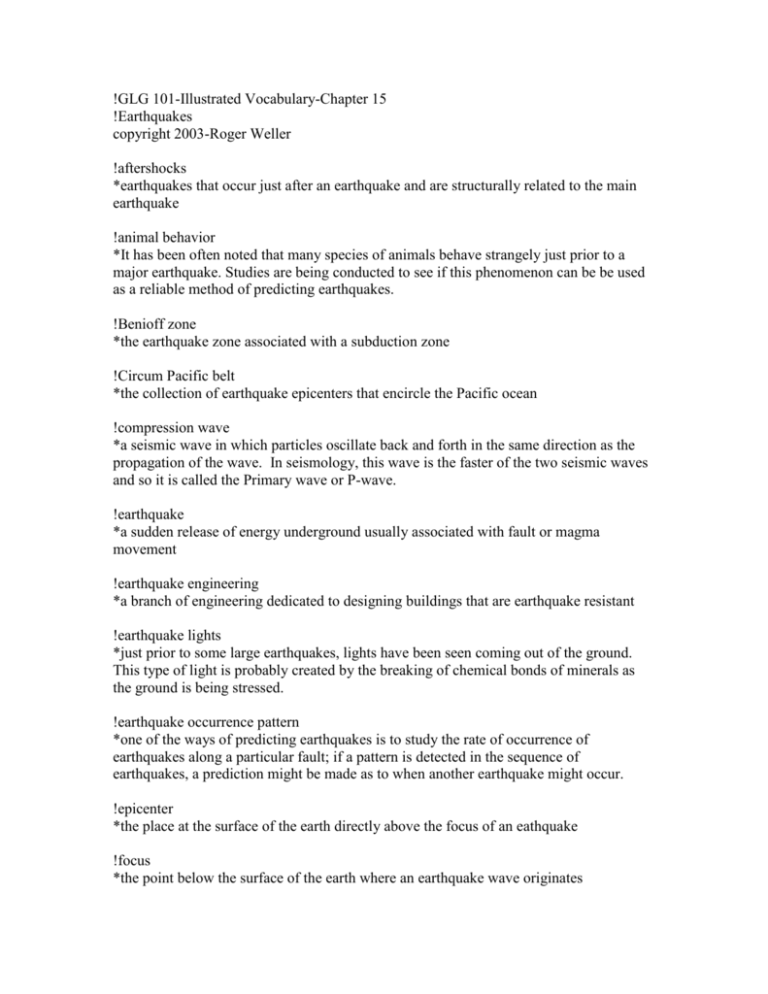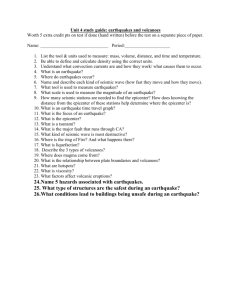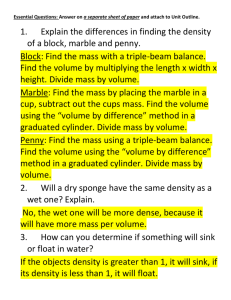physical geology-vocab
advertisement

!GLG 101-Illustrated Vocabulary-Chapter 15 !Earthquakes copyright 2003-Roger Weller !aftershocks *earthquakes that occur just after an earthquake and are structurally related to the main earthquake !animal behavior *It has been often noted that many species of animals behave strangely just prior to a major earthquake. Studies are being conducted to see if this phenomenon can be be used as a reliable method of predicting earthquakes. !Benioff zone *the earthquake zone associated with a subduction zone !Circum Pacific belt *the collection of earthquake epicenters that encircle the Pacific ocean !compression wave *a seismic wave in which particles oscillate back and forth in the same direction as the propagation of the wave. In seismology, this wave is the faster of the two seismic waves and so it is called the Primary wave or P-wave. !earthquake *a sudden release of energy underground usually associated with fault or magma movement !earthquake engineering *a branch of engineering dedicated to designing buildings that are earthquake resistant !earthquake lights *just prior to some large earthquakes, lights have been seen coming out of the ground. This type of light is probably created by the breaking of chemical bonds of minerals as the ground is being stressed. !earthquake occurrence pattern *one of the ways of predicting earthquakes is to study the rate of occurrence of earthquakes along a particular fault; if a pattern is detected in the sequence of earthquakes, a prediction might be made as to when another earthquake might occur. !epicenter *the place at the surface of the earth directly above the focus of an eathquake !focus *the point below the surface of the earth where an earthquake wave originates !foreshock *a small earthquake that preceeds a larger earthquake in the same area !Mercalli scale *a system of numerical values, expressed in Roman numerals, that indicates the degree of surface damage caused by an earthquake !New Madrid, Missouri earthquakes *Major earthquakes that occurred in 1811 to 1812 in the extreme southeastern corner of Missouri at the northern end of the Mississippi Embayment. !p-wave (Primary Seismic Wave) *a seismic compression wave, so named because it travels faster and thus arrives earlier than the S-wave. !Richter scale *a numerical value in decimal form that is a rating of the amount of energy released by an earthquake. !San Francisco earthquake *In 1906 a large movement along the San Andreas fault in California produced a major earthquake that destroyed most of San Francisco. !seismic sea wave *this is the correct term to use in referring to large ocean waves created by earthquakes. Earlier terms applied to these waves were tidal waves and tsunamis. !seismograph *a device that records an earthquake !seismogram *a record of an earthquake produced by a seismograph !seismologist *a scientist who studies earthquakes !seismology *the science of studying earthquakes !seismometer *a device that detects earthquakes !shear wave *a seismic wave in which particles oscillate at right angles to the direction of propagation of the wave. In seismology, this slower moving wave is known as the Secondary wave or S-wave. !surface wave *a seismic wave that travels along the surface of the Earth; it resembles an ocean wave, but it is moving through sediments. !S-wave (Secondary Seismic Wave) *a seismic wave in which the motion of disturbed particles is at right angles to the direction of propagation of the wave; a shear wave. This type of wave is called a secondary wave because it travels slower than a P-wave and so arrives second. !travel-time graph *time of travel of P and S seismic waves waves is plotted versus distance. Using this graph, the difference in arrival times between the P-wave and the S-wave can be used to calculate the distance from the focus of the earthquake to the seismograph. !tsunami *Japanese word for seismic sea wave







